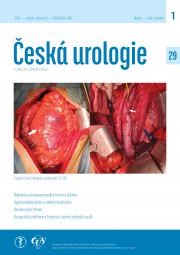Ces Urol 2014, 18(1):26-32 | DOI: 10.48095/cccu2014004
Radical prostatectomy - analysis of 191 cases examined using whole-mount section method
- 1 Oddělení speciální diagnostiky Šiklův patologicko-anatomický ústav FN a LF, Plzeň
- 2 Urologická klinika FN a LF, Plzeň
- 3 Klinika zobrazovacích metod FN a LF, Plzeň
Aim:
This work aims to present the advantages of histological processing using whole-mount sections (WMS) and to compare it with other methods commonly used for evaluation of tissue removed during the course of a radical prostatectomy (RP).
Material and methods:
All cases of carcinoma of the prostate, treated by radical prostatectomy, and processed using WMS, August 2009 to March 2013 were histologically re-evaluated. The following parameters were analyzed: histological type, Gleason score, presence of a tumour in the apex, multicentricity, infiltration of the seminal vesicles, presence of positive resection margins and extracapsular extension.
Results:
There were 191 RP specimens processed with WMS. Histological diagnosis of acinar prostatic adenocarcinoma was made in 97.4% of cases. The most frequent Gleason score was 6 (3 + 3) in 42.9%. In 20.4%, the tumour was multicentric. Invasion of the apex was found in 127 cases. The extracapsular extension was detected in 20.9%. The metastatic infiltration of the lymph nodes was registered in 2.1%. The presence of positive resection margins in the specimen was detected in 36.1%. Infiltration of seminal vesicles was present in 12.0%. Invasion of the neural-vascular bundle was detected in 3.7% and invasion of the striated muscle of the external sphincter in 3.1% of cases.
Conclusions:
WMS allows precise determination of the disease stage and Gleason score. It also facilitates precise detection of positive surgical margins. The routine use of WMS can be recommended in histopathological diagnostics of prostate cancer due to its obvious benefits for the patient.
Keywords: prostate, prostate cancer, adenocarcinoma, whole-mount section, staging
Received: September 25, 2013; Accepted: December 2, 2013; Published: January 1, 2014
References
- Jarolím L, Veselý Š, Babjuk M, Schmidt M, Dušek P, Malinová B, Prausová J. Časná salvage radioterapie po radikální prostatektomii indukovaná u pacientů s rostoucí hladinou PSA v hodnotách nižších, než je konvenční hranice biochemické recidivy 0,2 ng/ml. Ces Urol 2012; 16(2): 92-100.
- Bostwick DG, Cheng L. Urologic Surgical Pathology. Second ed. Mosby 2008; 446-546.
- Cohen MB, Soloway MS, Murphy WM. Sampling of radical prostatectomy specimens. How much is adequate? Am J Clin Pathol 1994; 101: 250-252.
 Go to original source...
Go to original source...  Go to PubMed...
Go to PubMed... - Hall GS, Kramer CE, Epstein JI. Evaluation of radical prostatectomy speciimens. A comparative analysis of sampling methods. Am J Surg Pathol 1992; 16: 315-324.
 Go to original source...
Go to original source...  Go to PubMed...
Go to PubMed... - Sakr WA, Wheeler TM, Blute M, et al. Staging and reporting of prostate cancer-sampling of the radical prostatectomy specimen. Cancer 1996; 78: 366-368.
 Go to original source...
Go to original source...  Go to PubMed...
Go to PubMed... - Sehdev AE, Pan ML, Epstein JI. Comparative analysis of sampling methods for grossing radical prostatectomy specimens performed for nonpalpable (stage T1c) prostatic adenocarcinoma. Hum Pathol 2001; 32: 494-499.
 Go to original source...
Go to original source...  Go to PubMed...
Go to PubMed... - Epstein JI, Amin MB, Boccon-Gibod L, et al. Prognostic factors and reporting of prostate carcinoma in radical prostatectomy and pelvic lymphadenectomy specimens. Scand J Urol Nephrol Suppl 2005; 216: 34-63.
 Go to original source...
Go to original source...  Go to PubMed...
Go to PubMed... - Srigley JR. Key issues in handling and reporting radical prostatectomy specimens. Arch Pathol Lab Med 2006; 130: 303-317.
 Go to original source...
Go to original source...  Go to PubMed...
Go to PubMed... - Srigley JR, Amin MB, Epstein JI, et al. Uptdated protocol for the examination of specimens from patients with carcinomas of the prostate gland. Arch Pathol Lab Med 2006; 130: 936-946.
 Go to original source...
Go to original source...  Go to PubMed...
Go to PubMed... - Desai A, Wu H, Sun L, et al. Complete embedding and closes tep-sectioning of radical prostatectomy specimens both increase detection of extra-prostatic extension, and correlate with increased disease-free survival by stage of prostate cancer patients. Prostate Cancer Prostatic Dis 2002; 5: 212-218.
 Go to original source...
Go to original source...  Go to PubMed...
Go to PubMed... - Staník M, Čapák I, Macík D, Bolčák K, Lžičařová E, Vašina J, Šustr M, Miklánek D, Doležel J. Vyšetření sentinelové uzliny u karcinomu prostaty-mapování primární lymfatické drenáže a zhodnocení přínosu pro staging onemocnění. Ces Urol 2013; 17(1): 42-50.
- Doležel J, Tvarůžek J, Staník M, Zachoval R, Šimoník I, Korsa M, Vagunda V. Časné zkušenosti s roboticky asistovanou laparoskopickou radikální prostatektomi - prvních 153 pacientů.


